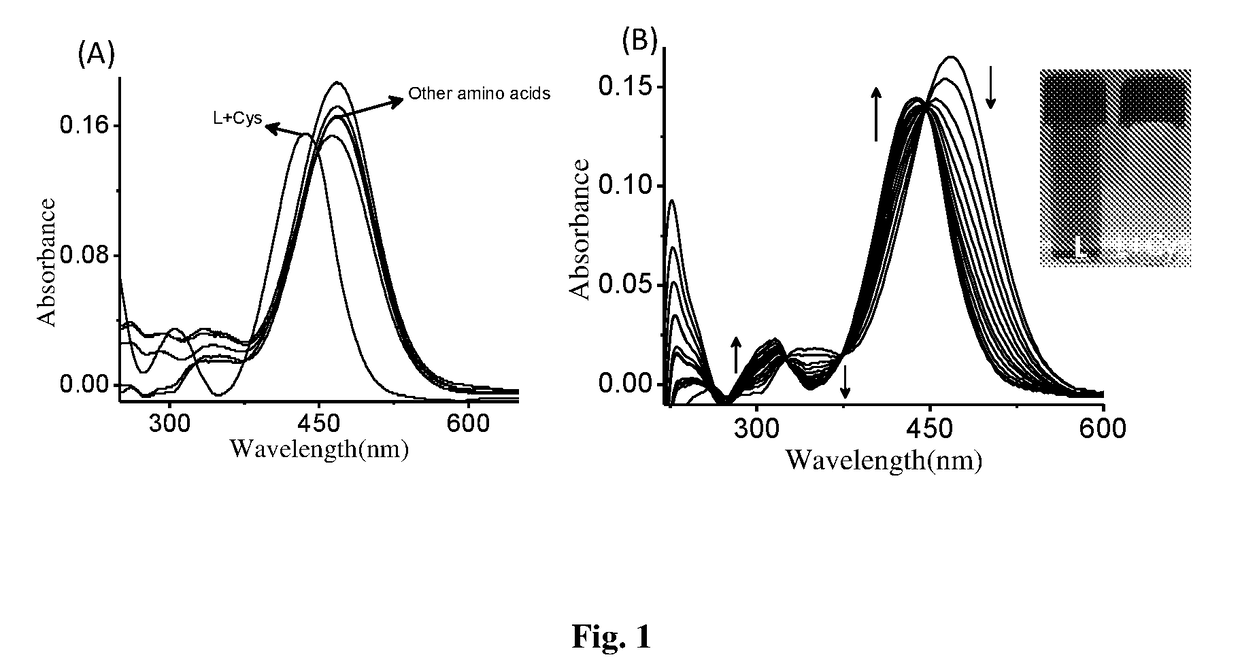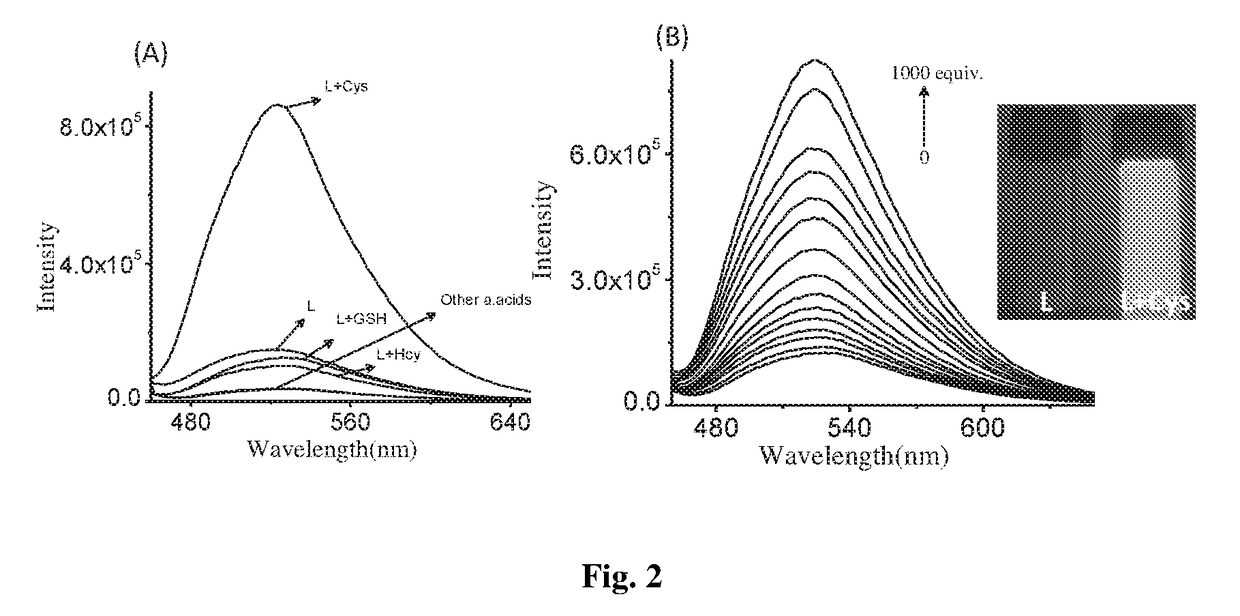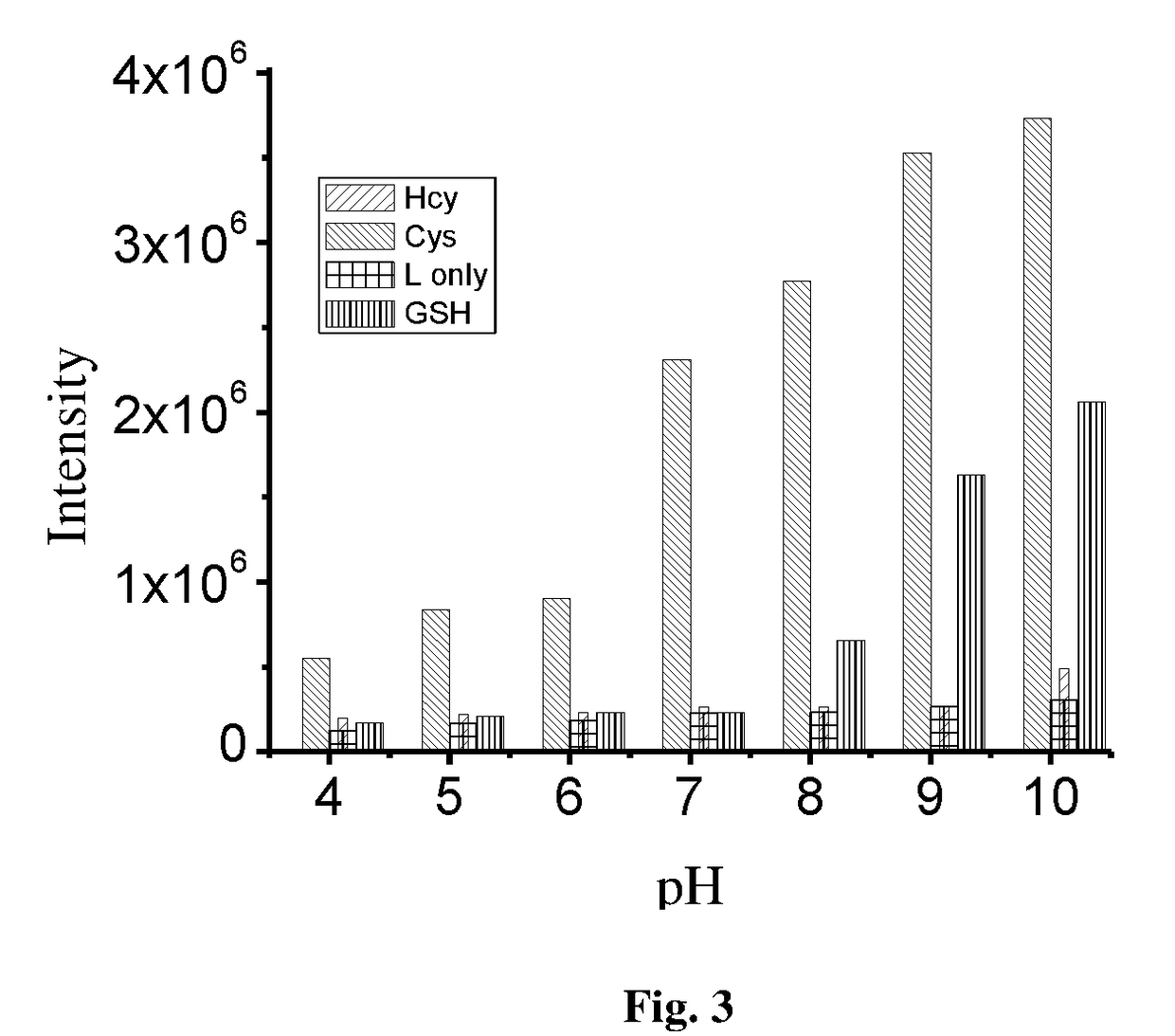Coumarin derivative for detection of cysteine and process for the synthesis thereof
a technology of cysteine and coumarin derivative, which is applied in the field of coumarin derivative, can solve the problems of affecting the detection effect of cysteine, and affecting the detection effect of cysteine, and achieves the challenge of distinguishing biothiols, and reducing the number of cysteine residues
- Summary
- Abstract
- Description
- Claims
- Application Information
AI Technical Summary
Benefits of technology
Problems solved by technology
Method used
Image
Examples
example 1
of [7-(diethylamino)-3-vinyl-2H-chromen-2-one]
[0125]Under N2 atmosphere, to a solution of vinyl acetic acid (0.28 mL, 3.23 mmol) in dry CH2Cl2, DCC (667.45 mg, 3.23 mmol) was added and stirred at 0° C. for 1 hr. To this, 4-(diehtylamino) salicylaldehyde (500 mg, 2.58 mmol) and DMAP (40 mg, 0.32 mmol) were added and it was stirred at room temperature for 3 hrs.
[0126]Reaction was monitored by TLC. Once the reaction was completed, the solid was filtered and to the filtrate CS2CO3 (843 mg, 2.58 mmol) was added and it was stirred for 12 hrs to complete the reaction. The mixture was washed with H2O, dried, concentrated under vacuum. The crude product was purified by column chromatography to give vinylcoumarin as greenish yellow solid. Since the compound is labile, it was stored in cold condition. Yield-56%. IR (film) νmax: 1707 (CO), 1597 (C═C), 3017 (—C═C—H) cm−1. 1H NMR (CDCl3, 400 MHz): δ (ppm) 1.19 (6H, t, CH3), 3.38 (4H, q, CH2), 5.26 (1H, d, J=11.45 Hz, CH), 5.98 (1H, d, J=17.40 Hz)...
example 2
of (E)-4-(2-(7-(diethylamino)-2-oxo-2H-chromen-3-yl)vinyl)benzaldehyde
[0127]Vinylcoumarin (75 mg, 0.30 mmol) was taken in dry DMF, to this 4-bromobenzaldehyde (64 mg, 0.36 mMol), sodium acetate (28 mg, 0.33 mmol) and triphenyl phosphine (64.67 mg, 0.24 mmol) was added and it was purged with N2 and was added Pd(OAc)2 (14 mg, 0.06 mmol). It was heated for 16 hrs at 80° C. under inert atmosphere; the completion of the reaction was monitored by TLC. Reaction mass was washed with H2O and brine solution, dried, concentrated under vacuum. The crude product was purified by column chromatography to give compound 2 as an orange red solid. Yield-80%. IR (film) νmax: 1696 (—CHO), 1612 (C═C), 3021 (—C═C—H) cm−1. 1H NMR (CDCl3, 400 MHz): δ (ppm) 1.25 (6H, t, CH3), 3.46 (4H, q, CH2), 6.52 (1H, d, J=1.96 Hz), 6.63 (1H, dd, J=8.8 Hz), 7.20 (1H, J=16.14 Hz), 7.28 (1H, t, J=8.80 Hz), 7.55 (1H, d, J=16.38 Hz), 7.65 (2H, d, J=8.07 Hz), 7.73 (1H, s), 7.85 (2H, d, J=8.07 Hz), 9.99 (1H, s, CHO). 13C NMR (C...
example 3
of 7-(diethylamino)-3-((E)-4-((E)-2-nitrovinyl)styryl)-2H-chromen-2-one (L)
[0128]Compound 2 (80 mg, 0.23 mmol) was dissolved in nitro methane (8 mL) and was added ammonium acetate (170 mg, 2.30 mmol). It was refluxed at the 85° C. for 3 hrs and reaction was monitored by TLC. After the completion of reaction, reaction mass was concentrated under vacuum and purified by column chromatography to give compound L as red solid. Yield-49%. IR (film) νmax: 1701 (CO), 1506 (N—O), 1615 (C═C), 3024 (—C═C—H) cm−1. 1H NMR (DMSO-d6, 400 MHz): δ (ppm) 1.14 (6H, t, CH3), 3.45 (4H, q, CH2), 6.57 (1H, s), 6.74 (1H, d, J=8.80 Hz), 7.27 (1H, d, J=16.14 Hz), 7.47 (1H, d, J=8.80 Hz), 7.53 (1H, d, J=16.38 Hz), 7.64 (2H, d, J=8.07 Hz), 7.84 (2H, d, J=8.07 Hz), 8.10 (1H, s), 8.14 (1H, d, J=15.45 Hz), 8.22 (1H, J=13.45 Hz). 13C NMR (DMSO-d6, 400 MHz): δ (ppm) 12.83, 44.64, 96.74, 108.85, 109.99, 116.08, 126.78, 127.30, 128.40, 129.66, 130.16, 130.96137.85, 139.43, 141.25, 141.78, 151.21, 155.93, 160.59. HRMS ...
PUM
| Property | Measurement | Unit |
|---|---|---|
| temperature | aaaaa | aaaaa |
| temperature | aaaaa | aaaaa |
| temperature | aaaaa | aaaaa |
Abstract
Description
Claims
Application Information
 Login to View More
Login to View More - R&D
- Intellectual Property
- Life Sciences
- Materials
- Tech Scout
- Unparalleled Data Quality
- Higher Quality Content
- 60% Fewer Hallucinations
Browse by: Latest US Patents, China's latest patents, Technical Efficacy Thesaurus, Application Domain, Technology Topic, Popular Technical Reports.
© 2025 PatSnap. All rights reserved.Legal|Privacy policy|Modern Slavery Act Transparency Statement|Sitemap|About US| Contact US: help@patsnap.com



